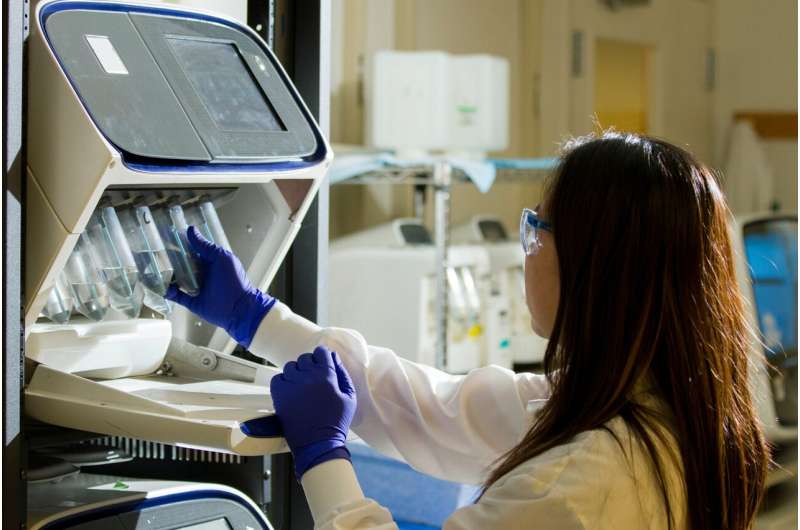This article has been reviewed according to Science X's editorial process and policies. Editors have highlighted the following attributes while ensuring the content's credibility:
fact-checked
peer-reviewed publication
trusted source
proofread
Scientists identify genes linked to relapse in the most common form of childhood leukemia

Scientists from St. Jude Children's Research Hospital, Seattle Children's and the Children's Oncology Group (COG) have identified novel genetic variations that influence relapse risk in children with standard risk B-cell acute lymphoblastic leukemia (SR B-ALL), the most common childhood cancer.
The identification of genomic predictors of relapse in SR B-ALL provides a basis for improved diagnosis, precise tailoring of treatment intensity and potentially the development of novel treatment approaches. The study was published today in the Journal of Clinical Oncology.
Standard risk ALL has an excellent prognosis, with remission rates over 90%. However, around 15% of patients who achieve remission later experience a relapse.
Previous studies examining genomic alterations to predict relapse risk have primarily focused on high-risk ALL subgroups. SR B-ALL represents a larger group of patients and accounts for approximately half of children with ALL that relapse.
This study is one of the first to systematically examine genetic factors on a large scale that influence relapse risk in SR B-ALL.
"ALL, as the most common childhood cancer, is a great success story with over 90% of children cured. But there remains a population of children whose disease is not fully cured, and we've not completely understood why that's the case," said co-senior author, Charles Mullighan, MBBS (Hons), MSc, MD, St. Jude Comprehensive Cancer Center Deputy Director and Department of Pathology member.
"This study focused on that group of poorly understood cases, where we know less about the features that influence the risk of treatment not working and the disease coming back."
Identifying genetic variations that modulate risk
Genomic profiling identifies specific genetic alterations associated with cancer susceptibility, relapse risk and how tumors respond to therapeutics. These studies allow scientists and clinicians to predict how patients are likely to respond to therapy, providing insights that shape the treatment of childhood ALL.
Results from this collaborative study demonstrate the importance of genomic profiling in accurately determining patient risk in B-ALL, in conjunction with traditional criteria.
"We are planning to reduce conventional therapies in the future for children with ALL because we know that many patients can be cured with less therapy," explained co-senior author, Mignon Loh, MD, leader of Seattle Children's Cancer and Blood Disorders Center.
"We want to make sure we accurately identify those children, and because of the special design of the study, this project allowed us to do just that."
Loh is the COG ALL Committee chair emeritus, Seattle Children's Ben Towne Center for Childhood Cancer Research director, and head of Seattle Children's Division of Pediatric Hematology, Oncology, Bone Marrow Transplant and Cellular Therapy.
The scientists conducted genome and transcriptome sequencing on both SR B-ALL samples that relapsed and samples that remained in complete remission in a one:two ratio. They found that ALL subtypes, genetic alterations and patterns of aneuploidy (extra or missing chromosomes) were associated with the risk of relapse and time to relapse.
Some B-ALL subtypes, such as hyperdiploid and ETV6::RUNX1 ALL, had a low frequency of relapse, but others, including PAX5-altered, TCF3/4::HLF, ETV6::RUNX1-like and BCR::ABL1-like were associated with an increased risk of relapse.
Notably, the specific type of genetic changes within those B-ALL subtypes further influenced the risk of relapse. This work demonstrated that genetic variations and cancer subtypes influence relapse risk in SR B-ALL, and patients classified as standard-risk can have tumors with high-risk features.
"Whole genome sequencing was important to accurately and comprehensively identify these changes, and they could not all have been identified without it," explained Mullighan.
"Children with SR ALL should have their tumor cell genome sequenced upon their initial diagnosis to identify if their tumor cells have these high-risk features, so that their initial therapy intensity can be increased."
"Beyond conventional therapies, this information could also be used to develop and explore novel, personalized treatment strategies," added Loh.
More information: Ti-Cheng Chang et al, Genomic determinants of outcome in acute lymphoblastic leukemia: A Children's Oncology Group study, Journal of Clinical Oncology (2023). DOI: 10.1200/JCO.2023.41.16_suppl.10015
















